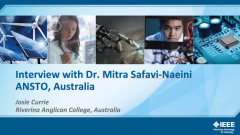Lauriston S. Taylor was a radiation physicist and a pioneer in the field of radiation safety. Except for a period of time overseas during World War II, he lived in Bethesda from 1930 to 1990, when he moved to the retirement center. Mr. Taylor joined the National Bureau of Standards in 1927 as the first federal employee to work in the rapidly growing area of X-ray applications in medicine and other sciences. His work led to the establishment of the first national standard for X-ray exposure. For the next seven decades, he studied the health effects of long-term exposure to low levels of radiation and other issues of radiation science. He also was founder and for 48 years president of the National Council on Radiation Protection and Measurements. "Lauriston Taylor combined a solid physics background with amazing talents as an administrator and politician," Thomas Tenforde, the council's current president, said in a statement released by the Bethesda-based organization. "He was able to attract leading scientists in physics, medicine, biology and public health to work as volunteers on the expert committees that produce [the council's] reports." As a 26-year-old researcher at the National Bureau of Standards, Mr. Taylor found out firsthand about radiation exposure. He was calibrating clinical radiation meters in an X-ray beam and forgot to replace a lead panel, thereby receiving several minutes of full-body exposure to radiation. "He seemed to have suffered no ill effects," his son Nelson Taylor said, noting his father's longevity. He used the mishap to construct a portable battery-operated meter to measure exposure rates. He also used the experience years later as a government witness in a number of court cases involving workers exposed to small amounts of radiation. He argued that small doses were not dangerous. At a time when doctors, nurses and medical technicians were badly burned by overdoses of high-level X-ray radiation, Mr. Taylor became the principal author of the first workplace radiation standards, established by the Bureau of Standards in 1934. "We didn't know anything really about body-organ response to radiation," he told the Boston Globe in a 1994 interview. "The evidence we had wasn't very much." He also organized the U.S. Advisory Committee on X-Ray and Radium Protection in 1929. His work with these groups and with the Council on Radiation Protection was integral to establishing definitive standards for X-ray shielding and for safe X-ray exposure limits for radiation workers and the public. The teams of scientists that created the first atomic bomb used the council's standards, which Mr. Taylor helped develop. Lauriston S. Taylor -- known as Laurie -- was born in Brooklyn, N.Y., and grew up in Maplewood, N.J. As a grade school student, he visited Thomas A. Edison at his laboratory in nearby South Orange, N.J. He attended the Stevens Institute of Technology in Hoboken, N.J., to study engineering but dropped out after a year to earn money for tuition. He then received a bachelor's degree from Cornell University but left shortly before finishing his doctorate in physics to join the Bureau of Standards. In 1940, the National Defense Research Committee commissioned Mr. Taylor to organize a new proximity fuse for antiaircraft ammunition. The British relied on the fuse to defend themselves against German air raids. In 1943, he set up an operations research program for the Army, first with the Army Air Forces' 8th Fighter Command and then with the 9th. Based in England, he was scientific adviser to Lt. Gen. Hoyt S. Vandenberg. As the war ended, he became director of the U.S. Continental Air Command's operations research division. He was awarded the Bronze Star and the Medal of Freedom for his work with the military. In 1946, he returned to the National Bureau of Standards as chief of the X-ray section (where he was known for his outlandish bow ties almost as much as his scientific accomplishments). In 1948, he took a year's leave of absence to organize and direct the U.S. Atomic Energy Commission's biophysics branch. His projects included early work on the long-range evaluation of strontium 90 from nuclear fallout. In 1962, he became associate director of the Bureau of Standards, retiring in 1965. He then moved to the National Academy of Sciences as special assistant to the president and executive director of the academy's advisory committee on emergency planning. He retired from the National Academy of Sciences in 1972, while continuing as president of the National Council on Radiation Protection until his third retirement, in 1977. He also continued consulting and writing until his late nineties. He wrote about 160 papers and all or part of 20 books, the last one at age 97. Taylor died at the age of 102 of Alzheimer's disease. Mr. Taylor's first wife, Azulah Walker Taylor, died in 1972. A son, Lauriston S. Taylor Jr., died in 1992. Survivors include his wife of 31 years, Robeana Taylor of Mitchellville; a son, Nelson Taylor of Pensacola, Fla.; four stepdaughters, Christine O'Shiell of Hilton Head, S.C., Carolyn Arthur of Woodlawn, Calif.; and Cynthia Nagle and Constance Taylor, both of Erie, Pa.; 18 grandchildren; 24 great-grandchildren; and two great-great-grandchildren.
Larson Collection interview with Lauriston S. Taylor, a radiation physicist and a pioneer in the field of radiation safety.
 Cart
Cart Create Account
Create Account Sign In
Sign In





